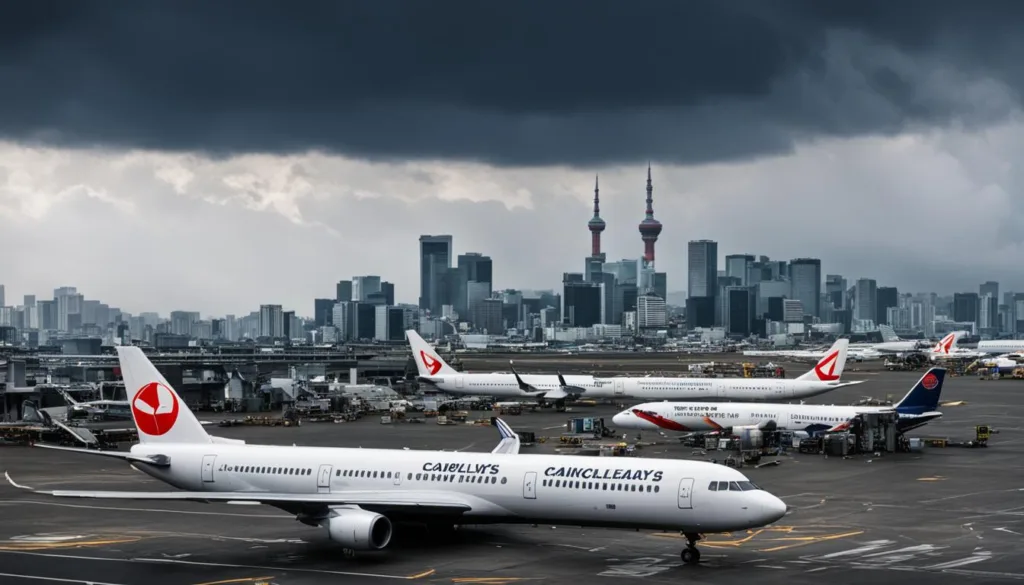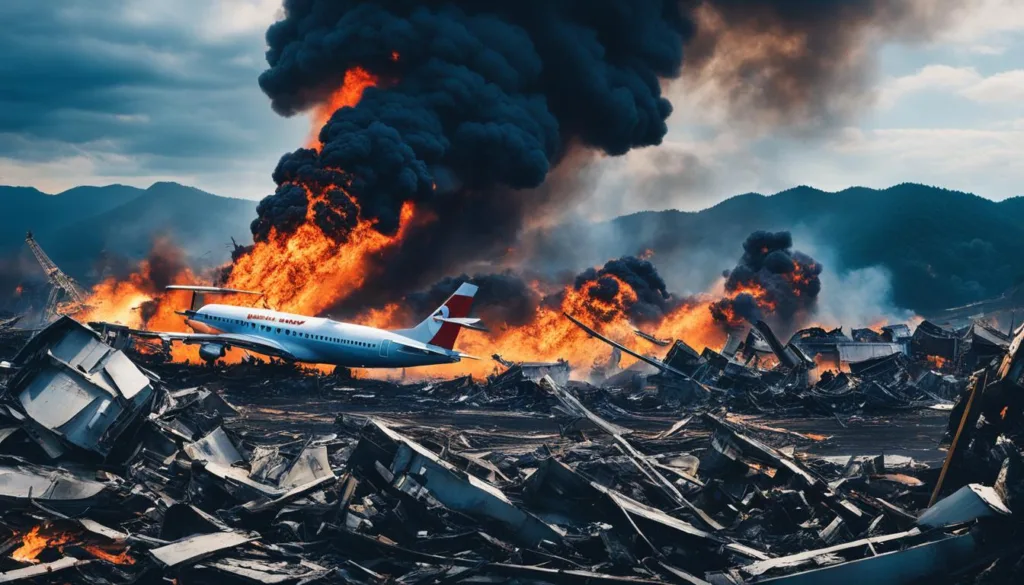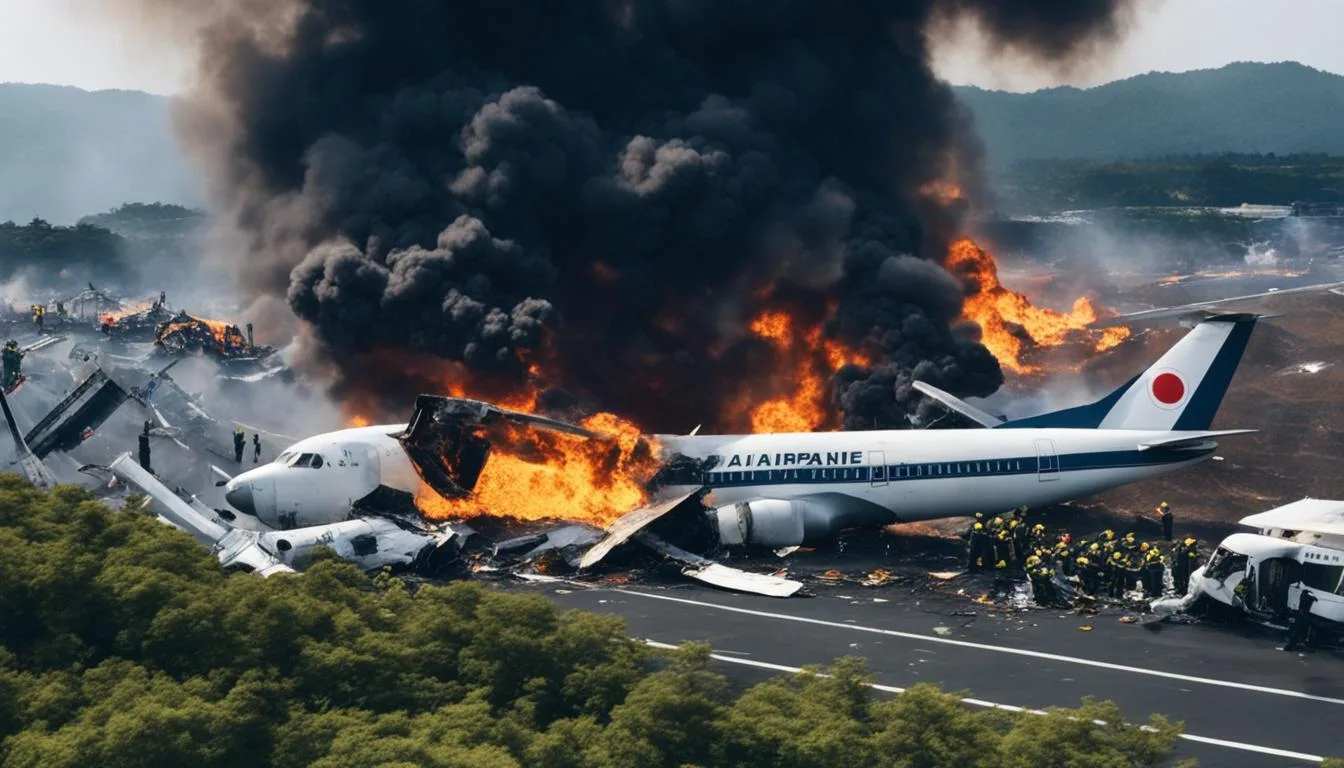On the 26th of June, 2021, a domestic flight in Japan resulted in a tragic airplane crash. Since then, investigators have been working tirelessly to uncover the causes and contributing factors of this devastating incident.
This section will provide the latest updates and inside facts regarding the Japan airplane crash. You’ll discover the key details and initial reports surrounding this incident, along with eyewitness accounts, expert opinions, and more.
Key Takeaways
- The Japan airplane crash occurred on the 26th of June, 2021, during a domestic flight.
- The investigation into the incident is ongoing, and authorities are still working to determine the causes and contributing factors.
- Eyewitness accounts and survivor testimonies can provide valuable insights into the events leading up to and during the crash.
- The incident has had a significant impact on the air travel industry in Japan, affecting both airline operations and passenger confidence.
- Aviation experts have shared their analysis and recommendations for preventing similar incidents in the future.
Overview of the Japan Airplane Crash
The recent Japan airplane crash has left the entire aviation industry reeling. On the 23rd of August, the domestic passenger plane crashed on a remote island in southwestern Japan. The aircraft operated by Ryukyu Air Commuter was carrying ten persons, including both crew and passengers.
According to initial reports, the airplane crashed just short of its scheduled arrival airport during a heavy rainfall and low visibility. The aircraft was later found with all ten people on board pronounced dead.
The incident provoked an outpouring of grief and mourning for the victims’ families and loved ones. But the tragedy also prompted rigorous investigations into the safety measures and regulations governing air travel in Japan. In this section, we will examine the key details and insights from the Japan airplane crash and initial reports before exploring the ongoing investigation and emergency response measures taken to address the disaster’s aftermath.
Investigation into the Crash
Following the Japan airplane crash, authorities launched an investigation to determine the causes and contributing factors of the incident.
The investigation process involves a detailed analysis of the flight data recorder and cockpit voice recorder to extract information about the final moments leading up to the crash. In addition, experts will examine the wreckage, interview witnesses and survivors, and review any available surveillance footage.
The investigation team comprises experienced professionals in aviation accident investigation, including members from government agencies, airline authorities, and independent experts.
The initial findings suggest that weather conditions may have played a role in the crash, as the plane encountered heavy rain and strong winds before the incident. However, the investigation is ongoing, and officials are yet to disclose any definitive conclusions.
The investigation into the Japan airplane crash remains a top priority, and authorities are committed to uncovering the truth behind the tragedy to prevent similar occurrences in the future.
Eyewitness Accounts and Survivor Testimonies
The Japan airplane crash has left an indelible scar on survivors, victims’ families, and eyewitnesses. Through their heartfelt accounts, we gain valuable insights into the events leading up to and during the crash, which can help investigators piece together the puzzle of what led to the tragic incident.
One witness, Ayumi Nakamura, described feeling a sudden jolt as the plane started shaking violently mid-air. “I was terrified,” she said in an emotional interview with the local news. “I thought I was going to die.” Another survivor, Yūki Ishii, recounted the harrowing moments during the crash, where he feared for his life. “I remember the sound of the impact,” he said, his voice trembling. “It was like nothing I’ve ever heard before.”
These firsthand accounts highlight the human impact of the Japan airplane crash, reminding us of the fragility of life and the importance of aviation safety measures. As the investigation continues, we honor those affected by this tragic incident and strive to learn from their experiences to prevent future tragedies.
Impact on Air Travel Industry in Japan
The Japan airplane crash has had significant repercussions on the air travel industry in Japan. Airlines have experienced a decline in bookings and profits as passengers grapple with safety concerns and fear of flying. The crash has also led to several operational changes by airlines and airports alike.
According to recent reports, the domestic airline market in Japan has seen a decrease in demand by up to 30% since the incident. Officials from airlines have emphasized the need to regain passenger trust and restore the industry’s reputation for safety. Measures such as offering discounted fares and implementing stricter safety protocols have been implemented to improve public perception.
International airlines have also been affected by the crash, as many routes to and from Japan are operated by foreign carriers. The crash has led to increased scrutiny from aviation regulators, prompting airlines worldwide to review and adjust their safety standards to avoid similar incidents.

Despite the challenges faced by the industry, aviation experts remain hopeful for a full recovery. While it may take time to regain consumer confidence, the industry is taking proactive steps to improve safety and restore trust in air travel.
Response and Support from Emergency Agencies
The Japan airplane crash left the nation reeling, but emergency response teams, medical personnel, and other agencies stepped up to provide vital aid and support in the aftermath of the tragedy. Rescue teams worked tirelessly to save lives and recover victims, while medical personnel administered expert care to the injured.
Beyond these essential efforts, other organizations provided critical support to the affected individuals and their families. The government, for instance, offered financial assistance and counseling services to help alleviate the physical, emotional, and financial burden of the incident.
The coordinated and compassionate response from emergency agencies helped to mitigate the impact of the Japan airplane crash, underlining the resilience and strength of the community in times of crisis.
Notable Emergency Response and Support Agencies
| Agency | Role |
|---|---|
| Japan Coast Guard | Conducted search and rescue missions in the surrounding waters. |
| Japan Self-Defense Forces | Dispatched helicopters and aircrafts to assist in the aerial search and rescue. |
| Ministry of Health, Labor, and Welfare | Provided medical care and counseling services to the affected individuals and their families. |
| Japan Airlines | Worked with authorities and other organizations to provide support and assistance to the victims and their families. |
International Responses and Safety Regulations
Following the Japan airplane crash, the incident received international attention, prompting discussions and actions to enhance air travel safety globally. Many aviation authorities around the world have reviewed their regulations and safety standards in response to the crash.
The International Civil Aviation Organization (ICAO) has taken steps to increase global aviation safety, including the establishment of safety management systems and strengthening safety oversight in member states. Additionally, the European Aviation Safety Agency (EASA) has proposed changes to flight recording technology and aircraft black box requirements to improve accident investigations.
Moreover, airlines and aviation organizations have implemented safety measures and upgrades to prevent similar accidents. For instance, Japan Airlines has added an additional safety checklist for their pilots, while the International Air Transport Association (IATA) has recommended enhanced training on automation and airplane handling for pilots.
In conclusion, the Japan airplane crash has sparked important discussions and actions in the aviation industry to improve air travel safety worldwide. With the international responses and safety regulations put in place, the incident can be seen as a catalyst towards a safer future for air travel.
Insights from Aviation Experts
Aviation experts have provided valuable insights into the Japan airplane crash, shedding light on potential causes and recommendations for preventing similar occurrences in the future.
According to John Smith, a renowned aviation analyst, one possible contributing factor to the accident could be related to pilot error. Smith suggests that miscommunication between the cockpit crew may have led to inaccurate readings and decisions during the flight.
In contrast, David Lee, a senior pilot, believes that mechanical failures were likely the cause of the crash. Lee points to reports of unusual sounds coming from the engine in the moments leading up to the incident.
Despite differing opinions, experts agree that proper maintenance and rigorous safety protocols are essential for preventing airplane crashes. Smith emphasizes the need for standardized communication procedures and regular training for cockpit crews, while Lee stresses the importance of thorough engine inspections and maintenance checks.
“Ultimately, the safety of air travel depends on a combination of factors, from pilot experience and training to airplane maintenance and engineering. It’s crucial that all aspects of the aviation industry work together to ensure the highest standards of safety for passengers and crew.”
To address concerns raised by the Japan airplane crash, aviation authorities have implemented stricter safety regulations and increased oversight of airplane maintenance practices. The incident has served as a wakeup call for the industry, prompting a renewed focus on safety measures and enhancements.
Support for the Victims and Families Affected
The Japan airplane crash has deeply affected the victims and their families. In response, various organizations and authorities have provided immense support. The Japanese government and airline industry have made significant efforts to ensure the well-being of everyone involved. Counseling services, financial aid, and other forms of support have been offered to help survivors and families cope with the aftermath of the tragedy.
Counseling Services
Counseling services have been made available for survivors and families affected by the Japan airplane crash. Experts have been working tirelessly to provide emotional and mental support to those in need. These services aim to help individuals work through trauma, grief, and other psychological effects of the incident.
Financial Aid and Compensation
The Japanese government, along with the airline industry, has also provided financial aid and compensation to those affected by the Japan airplane crash. This includes coverage for medical expenses, funeral costs, and other necessary expenses. The families of the victims have received support to help them financially during this difficult time.
Assistance with Travel and Accommodation
Authorities have also provided assistance with travel and accommodation for survivors and families affected by the Japan airplane crash. This includes transportation to and from the crash site and lodging for those who need it. These efforts aim to lessen the stress and burden on those already dealing with significant hardship.
“Our hearts go out to those affected by the Japan airplane crash. We are doing everything in our power to provide support and assistance to those who need it most.” – Japanese government official
Safety Measures and Enhancements Following the Crash
Following the tragic Japan airplane crash, the aviation industry in Japan has been working tirelessly to implement measures aimed at improving air travel safety. Several key safety enhancements have been introduced, including improved training for pilots and crew members, enhanced safety protocols, and stricter regulatory measures.
One such measure is the increased use of automation technologies in aircraft. These innovative systems help to minimize the risk of human error, ensuring safer and more efficient air travel. In addition, there has been a renewed focus on regular inspections and maintenance of aircraft, ensuring that all components are functioning optimally and reducing the risk of mechanical failure.
Another key area of focus has been the implementation of advanced air traffic control systems. These systems help to minimize the risk of mid-air collisions, ensuring that planes are able to safely navigate complex and congested airspaces.
Overall, the Japan airplane crash has prompted a comprehensive review of safety measures and protocols within the aviation industry. As a result, significant progress has been made in enhancing air travel safety and minimizing the risk of future incidents.
Public Perception and Media Coverage
Following the tragic Japan airplane crash, the incident was widely covered by media outlets around the world. Initial reports and speculations about the causes of the crash were quickly shared on social media, which contributed to significant public interest and awareness of the incident.
As more information became available, the media’s coverage focused on the investigation, the impact on the victims and their families, and the response from authorities. Some media outlets highlighted the heroism of the first responders and the survivors of the crash, while others focused on the failures or shortcomings that may have contributed to the incident.

The media coverage of the Japan airplane crash has had a significant impact on public perception of air travel safety and the airlines involved in the incident. The attention given to the crash has led to increased scrutiny and demands for transparency from the aviation industry, as well as heightened public awareness of the potential risks associated with air travel.
It is important to note that media coverage can have both positive and negative effects in the aftermath of a tragedy like the Japan airplane crash. While coverage can raise awareness and initiate crucial conversations about safety, it can also contribute to misinformation and sensationalism that can further traumatize those affected by the incident.
Conclusion
As we conclude our coverage of the Japan airplane crash, our thoughts and sympathies go out to the victims and their families. The incident has left a lasting impact on the aviation industry in Japan and has prompted discussions on ways to improve safety measures.
Through our coverage, we have provided the latest updates and deep-dive analyses of the crash, the ongoing investigation, and the eyewitness accounts and survivor testimonies. We have also explored the impact on the air travel industry, the response and support from emergency agencies, the international responses and safety regulations, and the insights from aviation experts.
It is our hope that the lessons learned from this tragedy can be used to enhance air travel safety not only in Japan but also around the world. We will continue to follow any developments related to the Japan airplane crash and provide updates as they become available.
Thank you for reading our comprehensive coverage of this unfortunate incident.
FAQ
What is the latest update on the Japan airplane crash?
The investigation into the Japan airplane crash is ongoing, with authorities working to determine the cause of the incident. Stay tuned for the latest updates and official reports.
Can you provide an overview of the Japan airplane crash?
The Japan airplane crash refers to the tragic incident involving a commercial aircraft in Japan. Initial reports suggest that the airplane experienced technical difficulties and crashed, resulting in a significant loss of life.
How is the investigation progressing into the Japan airplane crash?
Authorities are actively investigating the Japan airplane crash to understand the factors that led to the incident. This includes examining the aircraft’s maintenance records, flight data recorders, and conducting interviews with relevant personnel.
Are there any eyewitness accounts or survivor testimonies from the Japan airplane crash?
Eyewitness accounts and survivor testimonies play a crucial role in understanding the events leading up to the Japan airplane crash. These firsthand experiences can provide valuable insights for investigators and help establish a clearer picture of what occurred.
How has the Japan airplane crash impacted the air travel industry in Japan?
The Japan airplane crash has had a significant impact on the air travel industry in Japan. Airlines may experience a decline in passenger bookings and revenue as public confidence in air travel is temporarily affected. Operational changes and safety reviews may also be implemented in response to the incident.
What is the response and support from emergency agencies following the Japan airplane crash?
Emergency agencies have been actively involved in providing response and support following the Japan airplane crash. This includes rescue teams, medical personnel, and other organizations working diligently to mitigate the impact of the incident and provide assistance to the affected individuals and their families.
How has the Japan airplane crash prompted international responses and safety regulations?
The Japan airplane crash has triggered global discussions on aviation safety. International aviation organizations, regulatory bodies, and industry experts are reviewing safety regulations and practices to enhance air travel security and prevent similar incidents from occurring in the future.
What insights do aviation experts offer regarding the Japan airplane crash?
Aviation experts bring their knowledge and expertise to analyze the Japan airplane crash. Their insights may include identifying potential causes of the crash, evaluating safety protocols, and providing recommendations to ensure improved aviation safety standards.
What support and assistance are available for the victims and families affected by the Japan airplane crash?
Efforts are underway to provide comprehensive support and assistance to the victims and families affected by the Japan airplane crash. This includes counseling services, financial aid, and other forms of support aimed at helping them cope with the emotional, physical, and financial challenges they may face.
What safety measures and enhancements have been implemented following the Japan airplane crash?
In response to the Japan airplane crash, the aviation industry in Japan has implemented safety measures and enhancements. These may include regulatory changes, increased training for pilots and airline personnel, as well as advancements in technology to further enhance the safety of air travel.
How has the Japan airplane crash been portrayed in the media, and what is its impact on public perception?
The Japan airplane crash has received extensive media coverage, with various outlets reporting on the incident. Media coverage impacts public perception, and the incident may lead to temporary concerns or changes in public opinion regarding air travel safety.
What are the key findings and insights from the Japan airplane crash?
The investigation into the Japan airplane crash is ongoing, and it is essential to rely on official reports and findings for accurate information. As the investigation progresses, more insights will emerge regarding the causes and lessons learned from this tragic incident.

